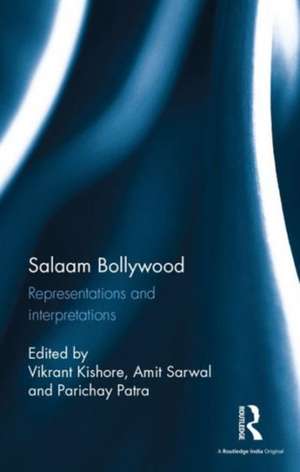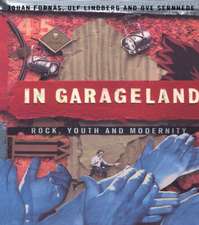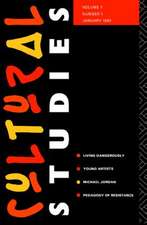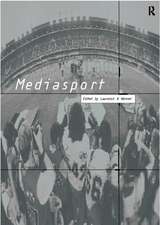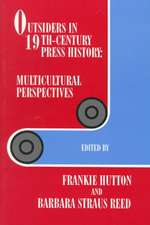Salaam Bollywood: Representations and interpretations
Editat de Vikrant Kishore, Amit Sarwal, Parichay Patraen Limba Engleză Hardback – apr 2016
One of the most comprehensive volumes on Bollywood, this work presents an analytical overview of the multiple histories of popular cinema in India and will be useful to scholars and researchers interested in film and media studies, South Asian popular culture and modern India, as well as to cinephiles and general readers alike.
| Toate formatele și edițiile | Preț | Express |
|---|---|---|
| Paperback (1) | 263.36 lei 6-8 săpt. | |
| Taylor & Francis – 14 iun 2019 | 263.36 lei 6-8 săpt. | |
| Hardback (1) | 1109.18 lei 6-8 săpt. | |
| Taylor & Francis – apr 2016 | 1109.18 lei 6-8 săpt. |
Preț: 1109.18 lei
Preț vechi: 1352.65 lei
-18% Nou
Puncte Express: 1664
Preț estimativ în valută:
212.24€ • 221.59$ • 175.66£
212.24€ • 221.59$ • 175.66£
Carte tipărită la comandă
Livrare economică 04-18 aprilie
Preluare comenzi: 021 569.72.76
Specificații
ISBN-13: 9781138649620
ISBN-10: 1138649627
Pagini: 336
Dimensiuni: 138 x 216 mm
Greutate: 0.45 kg
Ediția:1
Editura: Taylor & Francis
Colecția Routledge India
Locul publicării:Oxford, United Kingdom
ISBN-10: 1138649627
Pagini: 336
Dimensiuni: 138 x 216 mm
Greutate: 0.45 kg
Ediția:1
Editura: Taylor & Francis
Colecția Routledge India
Locul publicării:Oxford, United Kingdom
Public țintă
PostgraduateCuprins
Foreword. Introduction Part I. Histories: Mainstream and Alternative 1. Myths, Markets and Panics: Speculating about the Proto-Cinematic Historical Significance of the Popularity of Two Parsi Theatre Plays at the Turn of the Twentieth Century 2. The Left Encounter: Progressive Voices of Nationalism and Indian Cinema to the 1950s 3. Genre Mixing as Creative Fabrication 4. What Do the Villains Have? Indian Cinema’s Villains in the 1970s Hariprasad Athanickal 5. Inward Bound: Self-referentiality in Bombay Cinema Part II. Bollywood Dance: Re-reading History 6. Dancing to the Songs: History of Dance in Popular Hindi Films 7. Designing the Song and Dance Sequences: Exploring Bollywood’s Cinematic Creativity 8. The Item Girl: Tradition and Transgression in Bollywood Dancing Part III. Changes in the City Scape, Changes in Cinema 9. Regionalist Disjuncture in Bollywood: Dabangg and the Consumerist Cinema 10. Mourning and Blood-Ties: Macbeth in Mumbai 11. Black Friday: A Screen History of the 1993 Bombay Bomb Blasts 12. The Re-Mapped Dialectics of Contemporary Indian Cinema: Kahaani and That Girl in Yellow Boots Part IV. Other Regions, Other Nations 13. Marking out the "South" in/of Hindi Cinema: An Approach via Remakes 14. Between Solidarity and the Stereotype: Chandni Chowk to China 15. The Khan Mania: Universal Appeal of Superstar Shahrukh Khan in a Post-globalized Bollywood Era 16. Old Wine in a New Bottle: Bollywood Films Shot in Australia after 9/11 17. The Way Cinema was Banished: The Intervention of Cinema Studies in India
Notă biografică
Vikrant Kishore is an academic, film-maker, journalist, photographer and currently Lecturer in Media at RMIT University, Melbourne, Australia.
Amit Sarwal is Honorary Associate Professor at RMIT University, Melbourne, Australia and Founding Convenor of the Australia–India Interdisciplinary Research Network.
Parichay Patra is a doctoral candidate in the Department of Film and Screen Studies, School of Media, Film and Journalism, Monash University, Melbourne, Australia.
Amit Sarwal is Honorary Associate Professor at RMIT University, Melbourne, Australia and Founding Convenor of the Australia–India Interdisciplinary Research Network.
Parichay Patra is a doctoral candidate in the Department of Film and Screen Studies, School of Media, Film and Journalism, Monash University, Melbourne, Australia.
Descriere
This book traces the journey of popular Hindi cinema from 1913 to contemporary times when Bollywood has evolved as a part of India’s cultural diplomacy. The essays critically consider transformations of the Hindi film industry, issues of gender, dance and choreography, Bombay cinema’s negotiations with cityscape and urbanisms, and concentrate on its multifarious regional, national and transnational implications in the 21st century.
